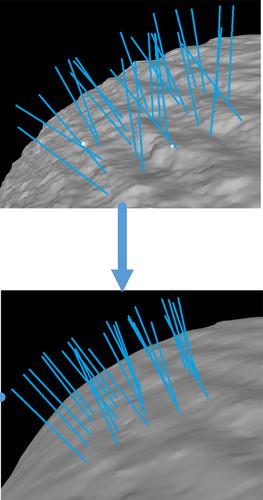当前位置:
X-MOL 学术
›
Photogramm. Rec.
›
论文详情
Our official English website, www.x-mol.net, welcomes your feedback! (Note: you will need to create a separate account there.)
Post‐filtering with surface orientation constraints for stereo dense image matching
The Photogrammetric Record ( IF 2.4 ) Pub Date : 2020-09-20 , DOI: 10.1111/phor.12333 Xu Huang 1 , Rongjun Qin 1, 2, 3
The Photogrammetric Record ( IF 2.4 ) Pub Date : 2020-09-20 , DOI: 10.1111/phor.12333 Xu Huang 1 , Rongjun Qin 1, 2, 3
Affiliation

|
Dense image matching (DIM) is a critical technique when computing accurate 3D geometric information for many photogrammetric applications. Most DIM methods adopt first‐order regularisation priors for efficient matching, which often introduce stepped biases (also called fronto‐parallel biases) into the matching results. To remove these biases and compute more accurate matching results, this paper proposes a novel post‐filtering method by adjusting the surface orientation of each pixel in the matching process. The core algorithm formulates the post‐filtering as the optimisation of a global energy function with second‐order regularisation priors. A compromise solution of the energy function is computed by breaking the optimisation into a collection of sub‐optimisations of each pixel in a local adaptive window. The proposed method was compared with several state‐of‐the‐art post‐filtering methods on indoor, aerial and satellite datasets. The comparisons demonstrate that the proposed method obtains the highest post‐filtering accuracies on all datasets.
中文翻译:

具有表面方向约束的后过滤,用于立体密集图像匹配
当为许多摄影测量应用计算准确的3D几何信息时,密集图像匹配(DIM)是一项关键技术。大多数DIM方法采用一阶正则化先验进行有效匹配,这通常会在匹配结果中引入阶跃偏差(也称为正平行偏差)。为了消除这些偏差并计算出更准确的匹配结果,本文提出了一种通过在匹配过程中调整每个像素的表面方向的新型后滤波方法。核心算法将后过滤公式化为具有二阶正则化先验的全局能量函数的优化。通过将优化分解为局部自适应窗口中每个像素的子优化集合,可以计算出能量函数的折衷解决方案。将该方法与室内,航空和卫星数据集上的几种最新的后过滤方法进行了比较。比较结果表明,所提出的方法在所有数据集上均具有最高的后过滤精度。
更新日期:2020-09-21
中文翻译:

具有表面方向约束的后过滤,用于立体密集图像匹配
当为许多摄影测量应用计算准确的3D几何信息时,密集图像匹配(DIM)是一项关键技术。大多数DIM方法采用一阶正则化先验进行有效匹配,这通常会在匹配结果中引入阶跃偏差(也称为正平行偏差)。为了消除这些偏差并计算出更准确的匹配结果,本文提出了一种通过在匹配过程中调整每个像素的表面方向的新型后滤波方法。核心算法将后过滤公式化为具有二阶正则化先验的全局能量函数的优化。通过将优化分解为局部自适应窗口中每个像素的子优化集合,可以计算出能量函数的折衷解决方案。将该方法与室内,航空和卫星数据集上的几种最新的后过滤方法进行了比较。比较结果表明,所提出的方法在所有数据集上均具有最高的后过滤精度。


























 京公网安备 11010802027423号
京公网安备 11010802027423号